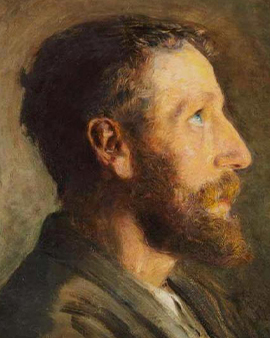


The Danish painter Laurits Andersen Ring was an important representative of symbolism and realism in the 19th and 20th centuries. Today, works by him can be found in practically every art museum worth mentioning in Denmark. Originally he was called only Laurits Andersen. Ring is the name of the village on the island of Zealand where he was born. He adopted the name so as not to be confused with the painter Hans Andersen (who later called himself H. A. Brendekilde), a friend of his.
Laurits Andersen Ring lived for some time in Copenhagen, where he maintained a close friendship with the lawyer Alexander Wilde and his wife Johanne, with whom he fell in love. When he realized that his love would never be returned, he fell into deep depression for a time. Ring served as the model for a character in the story "Night Watch." This story was the work of his old friend Henrik Pontoppidan, who would later receive the Nobel Prize in Literature. The character based on Ring is a painter and failed revolutionary who falls in love with his best friend's wife. Ring did not disagree with the account, but probably secretly felt hurt by the fact that his friend Pontoppidan revealed details of his private life to the public in this way. He ended the friendship without giving any explanation. When he was already over 40 years old, Ring married the artist Sigrid Kähler, who was 20 years younger. Before that, he had already portrayed her several times. At the World's Fair in Paris, held in 1900, he won a prize for a painting showing his pregnant wife standing in the doorway and looking at the garden of the house. The couple had three children. Ring became a widower when Kähler died at the age of 49. One of his sons, Ole Ring, later became a painter as well, using a style that closely resembled his father's.
As an artist, Ring never tried to distance himself from his humble origins, but on the contrary made them the dominant theme of his works, in which he depicted the realities of rural life. People working in the fields are among his most frequent motifs. In his landscape paintings, however, he also drew inspiration from psychological symbolism. He often enriched the landscapes with an other-worldly mysticism, which is sometimes called "anti-naturalism". Motifs illustrating the cycle of life and death also often appear in Ring's works. Another frequently recurring motif is roads and paths, as well as other types of lines, such as rivers, bridges, and railroad tracks. The lines depicted offer the viewer a way in and out of the painting, serving as a symbol of human existence.

The Danish painter Laurits Andersen Ring was an important representative of symbolism and realism in the 19th and 20th centuries. Today, works by him can be found in practically every art museum worth mentioning in Denmark. Originally he was called only Laurits Andersen. Ring is the name of the village on the island of Zealand where he was born. He adopted the name so as not to be confused with the painter Hans Andersen (who later called himself H. A. Brendekilde), a friend of his.
Laurits Andersen Ring lived for some time in Copenhagen, where he maintained a close friendship with the lawyer Alexander Wilde and his wife Johanne, with whom he fell in love. When he realized that his love would never be returned, he fell into deep depression for a time. Ring served as the model for a character in the story "Night Watch." This story was the work of his old friend Henrik Pontoppidan, who would later receive the Nobel Prize in Literature. The character based on Ring is a painter and failed revolutionary who falls in love with his best friend's wife. Ring did not disagree with the account, but probably secretly felt hurt by the fact that his friend Pontoppidan revealed details of his private life to the public in this way. He ended the friendship without giving any explanation. When he was already over 40 years old, Ring married the artist Sigrid Kähler, who was 20 years younger. Before that, he had already portrayed her several times. At the World's Fair in Paris, held in 1900, he won a prize for a painting showing his pregnant wife standing in the doorway and looking at the garden of the house. The couple had three children. Ring became a widower when Kähler died at the age of 49. One of his sons, Ole Ring, later became a painter as well, using a style that closely resembled his father's.
As an artist, Ring never tried to distance himself from his humble origins, but on the contrary made them the dominant theme of his works, in which he depicted the realities of rural life. People working in the fields are among his most frequent motifs. In his landscape paintings, however, he also drew inspiration from psychological symbolism. He often enriched the landscapes with an other-worldly mysticism, which is sometimes called "anti-naturalism". Motifs illustrating the cycle of life and death also often appear in Ring's works. Another frequently recurring motif is roads and paths, as well as other types of lines, such as rivers, bridges, and railroad tracks. The lines depicted offer the viewer a way in and out of the painting, serving as a symbol of human existence.
Page 1 / 1






